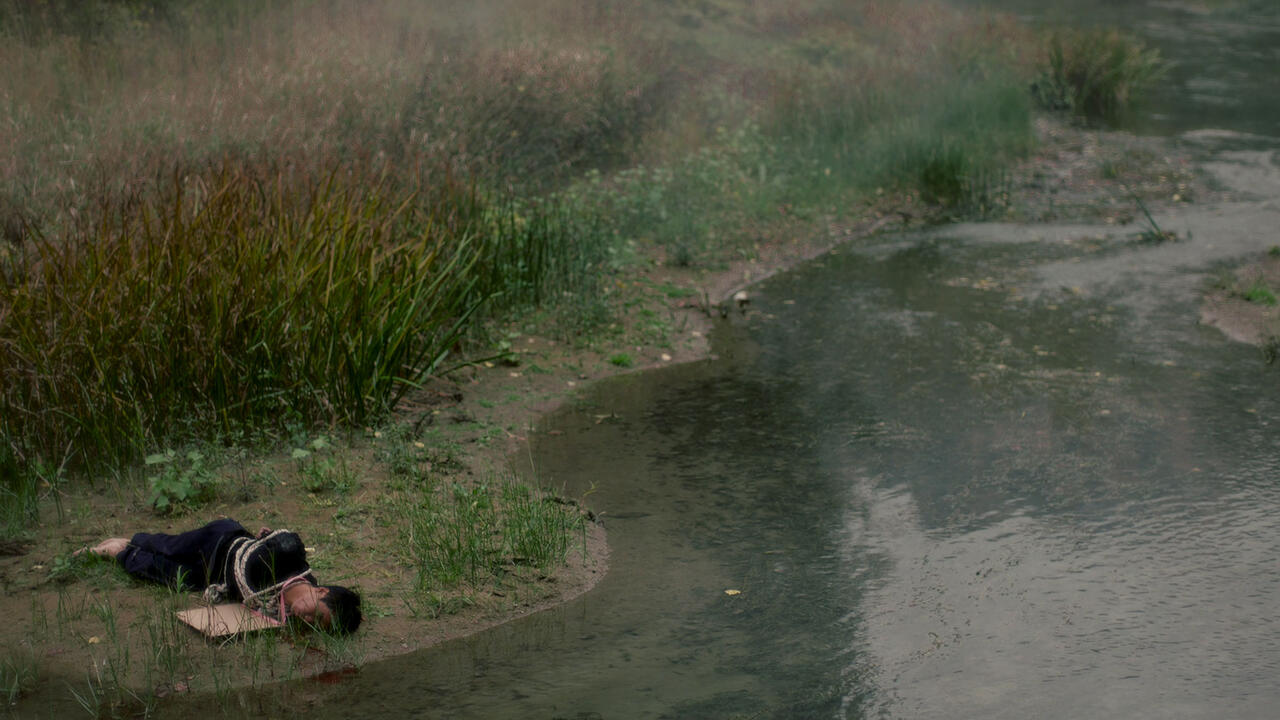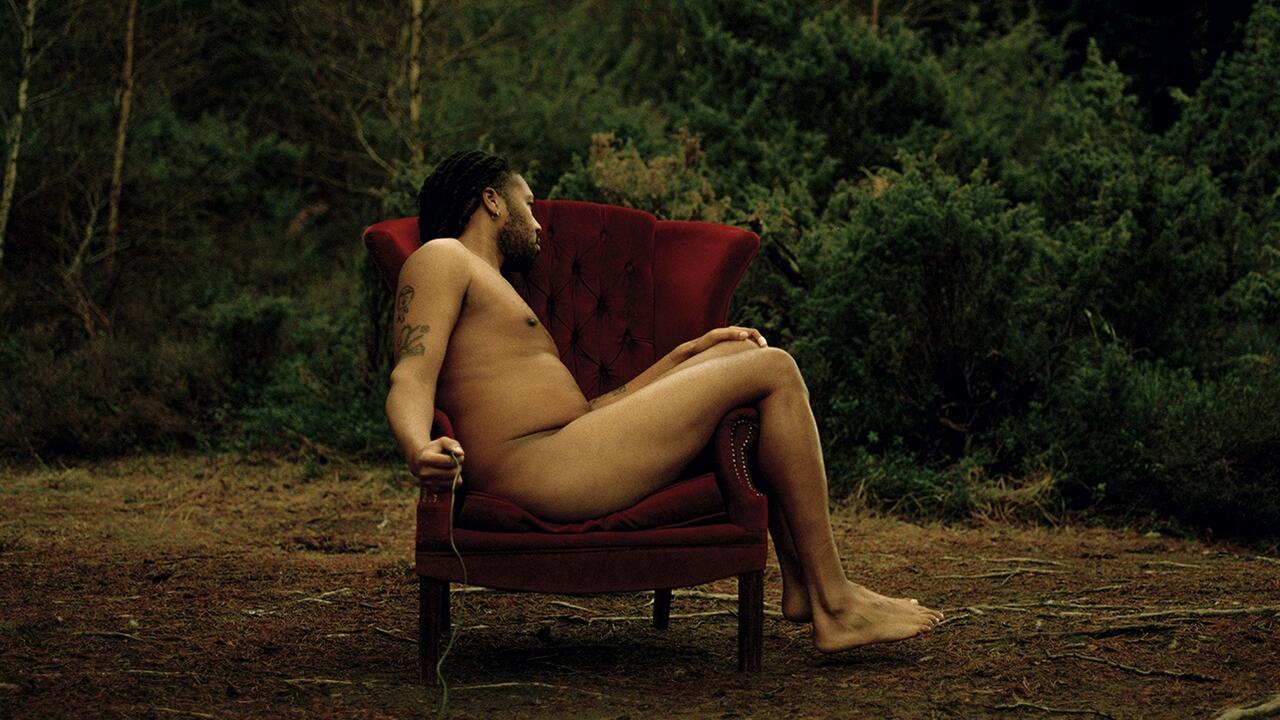Dance Moves
A ‘laboratory of mixed emotions’. The uncanny world of Meg Stuart’s dance pieces
A ‘laboratory of mixed emotions’. The uncanny world of Meg Stuart’s dance pieces

A small, cumbersome figure wrapped in a heavy robe of layered quilts, her mouth stuck in a grimace, each foot shackled to a sack of bricks as if about to be drowned. A picture that hurts, even if there is no story to accompany it – no tragedy, not even a scream. Arranged into this static-looking image, the dancer and choreographer Meg Stuart drags herself across the floor in her latest work Sketches/Notebook (2013). At the other end of the room, costume designer Claudia Hill, who dressed Stuart beforehand, strips her back down to her thin, naked skin.
Designers and live musicians are often seen on stage as performers in Stuart’s productions. The entire first part of Sketches belongs to Hill. Again and again, she readies the dancers for a brief photo shoot before tidily hanging all the props back on the clothes racks. These are acts without consequences, anti-processes like eating fast food, writing job applications, fruitless shopping trips. In Blessed (premiered in 2007 at Berlin’s Volksbühne), it was Jean-Paul Lespagnard who dressed the dancer Francisco Camacho (soaked, like the cardboard palm tree and swan props, by the artificial cloudburst on stage) in a beach towel and a death mask. The scene may be paradise or a typhoid-infested swamp, but at least the issue of style has been taken care of.
Asked whether her tendency to turn the stage into a dressing room points to a hidden Marie Antoinette complex, Stuart answers: ‘So not!’ Instead, she explains her need for designers by saying that ‘individualities are incomplete’. The artist herself is without makeup, in a brown vintage pullover, her bleached blonde hair tousled. The last two years have been restless but highly productive, with shows as different as the excessive VIOLET (premiered at PACT Zollverein, Essen in 2011), the eternal lottery of Built to Last (premiered at the Kammerspiele in Munich in 2012) and now the choreographic journal, Sketches/Notebook (premiered at Berlin’s Hebbel-am-Ufer in 2013). Damaged Goods, the company Stuart founded in 1994, is based in Brussels but her apartment is in Berlin. For the past two years, she had a project-based residency at the Kammerspiele in Munich and a fresh alliance is now beginning with Annemie Vanackere, the new manager and artistic director of Berlin’s hip Hebbel-am-Ufer (HAU). After her partnerships with Zurich’s Schauspielhaus and Berlin’s Volksbühne, this is a further, albeit loose association with a specific theatre.

Few of her European colleagues can match this record. Apart from Stuart, it is rare for contemporary choreographers to be offered residences at theatres where dance is not part of the usual programme. One high-profile exception was the experiment by Thomas Ostermeier and Sasha Waltz at Berlin’s Schaubühne, from 1999–2004, which came to an end for financial reasons. To hear Stuart tell the story, it sounds like her own career came about more by chance than design. Maybe that is part of her secret.
Sketches is now being staged as a striking start to her time at HAU. As so often in Stuart’s works, the light in the space seems to be filtered through celluloid. The quilted lady mentioned before also made an previous appearance, featuring under the working title Blanket Lady in the performance Moments (2012) at ZKM in Karlsruhe. This lady with the aura of a sad down-and-out queen, like something straight out of a Samuel Beckett play, gives an idea of the basic mood of many pieces by Stuart: the party is always already over, even when, as in Visitors Only (2003), it is still in full swing. There are faint glows at some points, but otherwise plenty of aimlessness and meaninglessness, mixed with a sense of somnambulistic resignation. In an interview with artist Catherine Sullivan in 2008, Stuart commented: ‘there is nothing I like more than to see someone on stage attempting an impossible task.’ Adding: ‘I only realized two years ago that my dancers had been performing a perverse form of slapstick all these years.’
Although there are pieces like Maybe Forever (2007) and BLESSED that hint at psychological figures or deal with specific relationship issues, even today the bodies of Stuart’s performers are more shells and sensory apparatuses than characters. They are somatic bodies that shiver, articulate ticks, pull faces, get in a whirl, become entangled. Not tied to any particular soul, they are traumatic dream dancers, free of pathos, impris‑oned in a vegetative fabric of interconnected movements. The ‘empty body’ is an important artistic tool for Stuart, as are her studies of trance-like states, providing a base from which the body can become a container and a laboratory of mixed emotions. This may also be what gives her works their often contemplative, even meditative quality, in spite of the aggressive music and abrupt scene changes. But this does not mean relaxation in the conventional sense. More of a David Lynch-like Mulholland Drive (2001) feeling, a perpetual nervousness that lasts and lasts until it has established a level of its own, becoming absolute.

Stuart’s oeuvre as a whole is also a kind of container, open to influences from almost every field of the arts. During her time in New York in the 1980s and early ’90s, she lived in SoHo, visiting several galleries a day. With hindsight, she says her sense of choreographic space was very much shaped by her studies of pictorial composition. This led to many collaborations with artists including Gary Hill, Ann Hamilton and Pierre Coulibeuf. In her book on Stuart, Bild in Bewegung und Choreographie (Image in Motion and Choreography, 2008), art theorist Annamira Jochim, who has spent years analyzing the artist’s works, inverts this relationship, looking for aspects of an expanded definition of the performativity of pictures. Material for this approach is provided above all by the different viewing angles in spatially fragmented choreographies like Highway 101 (2000) and Visitors Only. This line of argument is strengthened by the Sketches aesthetic with its partial audience mobility (during the performance, a whole row of seats is periodically placed on one of the artist’s signature ramps).
Stuart’s formats remain hard to pin down, however. The ‘pure’ dance of VIOLET (2011) was followed by Built to Last, absurd theoretical ballet danced by actors under raucous loudspeakers spewing distorted classical music, from Beethoven to Stockhausen. This was unusual for a choreographer who otherwise makes very deliberate use of live music. The almost moral perspective on humans, appearing animal-like under the monumentality of their cultural products, was another surprise. Choreographed and stage managed through and through, the piece is also likely to have alienated some fans, while coming as a relief to others. The audience must put up with this – after all, Stuart is not known for letting conceptual statements limit her scope for action. Surrendering to the process is the true constant across all the variation in her works: whether she is hosting workshops with a witch from New York in Stolzenhagen, the summer home of Berlin’s dance scene, or setting her performers on collision course with planets in a staged firmament. Perhaps her first experience in the theatre at age six was a formative one in this respect: coming from a theatrical family – her mother and father were directors, her grandfather a minstrel – she helped out as ‘substitute diminished witch’ in The Wizard of Oz. The reason? ‘Because the other girl got afraid.’
Translated by Nicholas Grindell
















